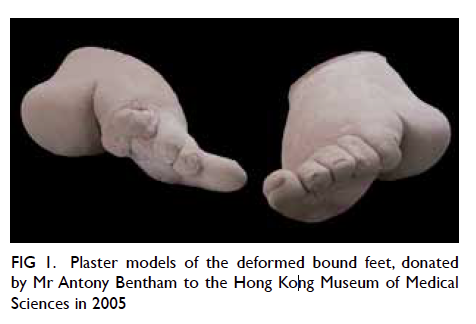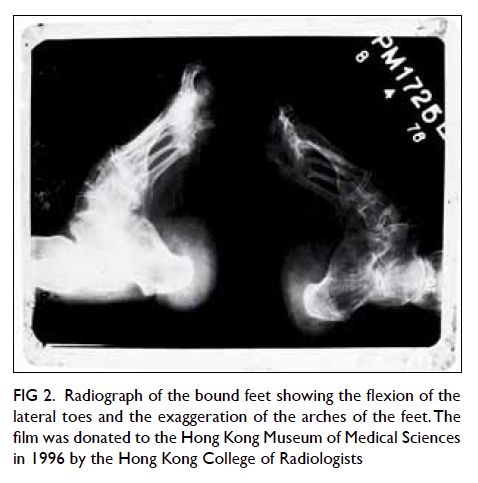© Hong Kong Academy of Medicine. CC BY-NC-ND 4.0
REMINISCENCE: ARTEFACTS FROM THE HONG KONG MUSEUM OF MEDICAL SCIENCES
The “golden lotuses”: bound feet
Condon Lee, Yan Tung
Hong Kong Museum of Medical Sciences
The practice of foot binding in Chinese women is
a cruel yet mysterious custom that continued for
over a thousand years. To civilised men at that time,
a pair of perfectly bound feet symbolised the ideal
of a woman’s beauty. The ‘golden lotuses’, as these
deformed feet were euphemistically called, were
regarded as pieces of art and objects of sexual desire.
The practice and history of foot binding have been
hotly discussed among historians.
The first written record of foot binding can
be traced to a book titled ‘Mo Zhuang Man Lu’
《墨莊漫錄》 by Zhang Bangji (張邦基), a scholar in the 12th century. According to Zhang, the practice
of foot binding began at the court of Li Yu (李煜),
the last emperor of the Southern Tang during the
Five Dynasties (907-960). He ordered his favourite
courtesan, Yao Niang (窅娘) to dance on a 6-foot-high
golden lotus, with her feet bound with white
silk cloth into the shape of a new moon. Other
dancers soon imitated the practice to attract the
attention of the emperor.1 The lotus foot became
the model of beauty among Chinese women. The
practice of foot binding started to flourish during
the Southern Song Dynasty (1127-1279) and was
encouraged by the renowned Confucian scholar Zhu
Xi (朱熹) who thought that it would restrain women
from unchaste and other immoral behaviour.2 By
the Ming Dynasty (1368-1644), foot binding was
widespread throughout China and the practice came
to be regarded as a symbol of high social status. For
many women the practice gave them ‘hope’ for a
promising marriage. As an old Chinese saying goes:
‘if you love your daughter, bind her feet; if you love
your son, let him study’.3
Foot binding had to start early at the age of 5 to
8 years before the arch of the foot had fully developed.
Its success depended on the skilful application of the
bandage—a process mostly carried out by the girl’s
mother or older sibling. One end of the bandage was
usually placed on the inside of the instep and carried
over the small toes, forcing them in towards the
sole. The big toe was left unbound. The bandage was
then wrapped around the heel forcefully to draw the
heel and toes close together. The aim was to make
the toes bend under and into the sole and to bring
the sole and heel as close together as was physically
possible (Figs 1 and 2).

Figure 1. Plaster models of the deformed bound feet, donated by Mr Antony Bentham to the Hong Kong Museum of Medical Sciences in 2005

Figure 2. Radiograph of the bound feet showing the flexion of the lateral toes and the exaggeration of the arches of the feet. The film was donated to the Hong Kong Museum of Medical Sciences in 1996 by the Hong Kong College of Radiologists
Foot binding drew the attention of foreigners
after China was forced to open to the imperial
powers in 1842. Dr John Preston Maxwell, a medical
missionary who went to Fujian from 1898 to 1919,
described two medical complications of foot
binding. The first was due to interference with blood
flow that caused skin ulcers, infection, and gangrene
associated with severe pain. If the foot was not
unbound, the toes or the whole foot could be lost. In
severe cases, women developed septicaemia to which
they might even succumb.4 The second complication
was displacement of the bones and weakening of the
ligaments of the ankle joints. Women with bound
feet had difficulty in walking because of the loss of
the normal architecture of the feet.
In 1997, a study of older women in Beijing
showed that the prevalence of bound feet was
surprisingly high—38% among women older than
80 years and 18% among those aged 70 to 79 years.
Compared with women with normal feet of the
same age, women with bound feet were significantly
more prone to fall and sustain hip fractures; less
able to squat or rise from a chair without assistance;
and less able to perform daily activities such as
preparing a meal, walking or climbing stairs. Their
limited weight-bearing activity led to reduced hip
bone density and increased risk of hip fracture from
falling,5 although a more recent study failed to show
such an increased risk, surmised by the authors as
possibly due to a compensatory improvement in
body balance.6
It was not until the late Qing Period in 1898
when Emperor Guangxu (reign 1875-1908), with
the support of Kang Youwei (康有為) and Liang
Qichao (梁啟超), led the Hundred Days’ Reform
that anti–foot binding became a national policy.
The ‘Foot Emancipation Society’ was formed to
encourage women to build ‘strong bodies and strong
action’. Kang and Liang’s efforts awakened liberal
consciousness among the Chinese. The movement
was discontinued after the Empress Dowager’s coup
but was reignited in 1902 when the Empress herself
issued an edict of anti–foot binding.7
When the Republic of China was established
in 1912, Dr Sun Yat-Sen promulgated an order to
prohibit foot binding on 13 March of the same year,
although it would be another 20 years before it
became a law of the Republic of China in 1932. The
practice of foot binding gradually disappeared in the
1950s.8
Acknowledgement
The authors are indebted to Prof Moira Chan-Yeung
for her invaluable advice.
References
1. Siku Quanshu 四庫全書. Available from: https://archive.org/details/06065053.cn. Accessed 18 Sep 2015.
2. Levy HS. Chinese footbinding: the history of a curious erotic custom. London: Neville Spearman; 1966: 44.
3. Ping W. Aching for beauty: footbinding in China. Minneapolis: University of Minnesota Press; 2000: 32.
4. Maxwell JP. On the evils of Chinese foot-binding. The China Medical Journal 1916;6:393-6.
5. Cummings SR, Ling X, Stone K. Consequences of foot binding among older women in Beijing, China. Am J Public
Health 1997;87:1677-9. Crossref
6. Qin L, Pan Y, Zhang M, et al. Lifelong bound feet in China: a quantitative ultrasound and lifestyle questionnaire
study in postmenopausal women. BMJ Open 2015;5:e006521. Crossref
7. Hong F. Footbinding, feminism and freedom: the liberation of women’s bodies in modern China. London: Frank
Cass; 1997: 66.
8. Gao JZ. Historical dictionary of modern China (1800-1949) (historical dictionaries of ancient civilizations and
historical eras). Maryland: Scarecrow Press Inc; 2009: 8.

